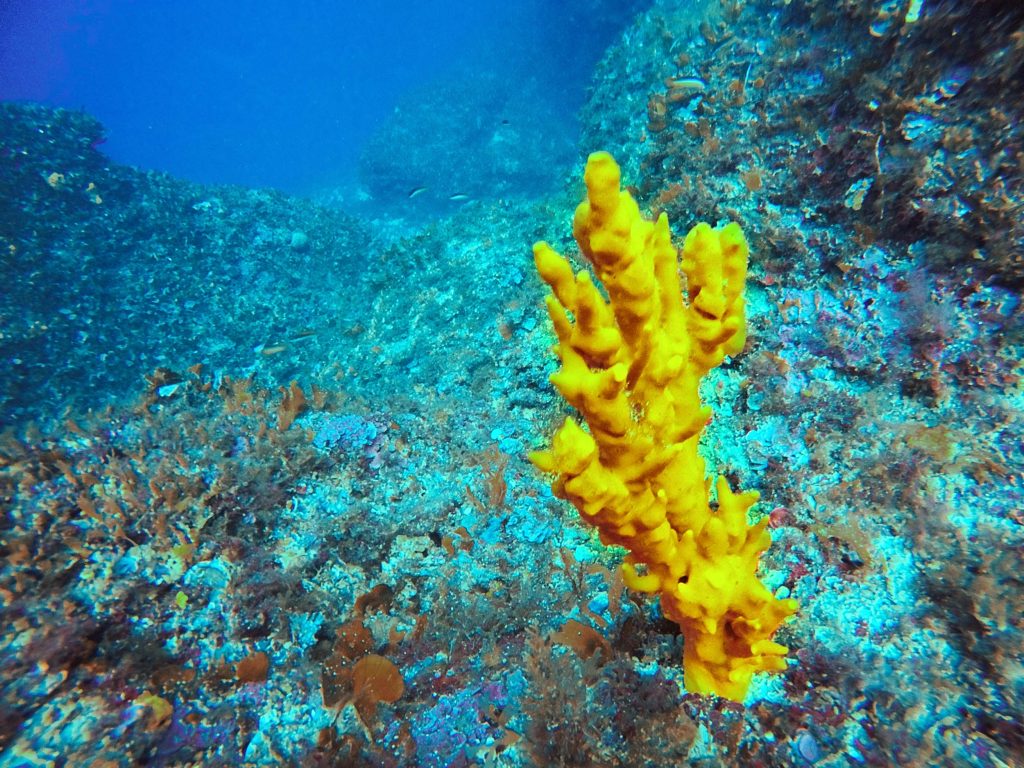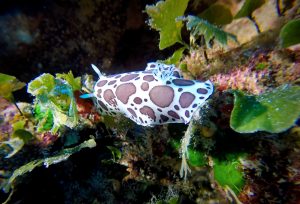Dwejra's Marine Environment
What will you learn in this section?

What kind of marine life do we find at Dwejra, and where do different species reside? How do Marine biologists classify the sea?

What can we do to protect the marine environment of Dwejra, and our seas generally?
Zonation
Marine biologists like to classify the sea according to depth as per the diagram on the right. Each zone depends on two main factors: brightness (i.e. how much light that zone receives), and wetness (i.e. how much time the zone spends submerged). The first zone, the Supralittoral, is always exposed (i.e. never submerged) but still sees the effect of sea spray. Next comes the Mediolittoral zone. In places other than the Mediterranean, the extremes of this zone depend on the tide. However, in the Mediterranean tide effects are small and therefore the extent of this zone is largely dependent on wave action. The zone underneath, the Infralittoral, extends all the way down to the limit where plants and algae stop receiving sufficient light to photosynthesize. Below this limit, we find the Circalittoral, which is dominated by animals rather than plants.
The waters of Dwejra host photophilic algae (i.e. algae that require large amounts of sunlight) down to depths of just over 25m; the water down to this depth is sufficiently well illuminated to support these lifeforms. In very shallow water, the scene one encounters is typically dominated by sea fir (Cystoseira), a genus of brown algae shown in the picture below. Cystoseira constitute an important habitat for various fish and invertebrates.


Dwejra Bay is home to Posidonia meadows (which was the original reason why Dwejra was designated a Marine Protected Area). Unfortunately, these Posidonia beds are sometimes damaged by boats anchoring in this bay. Crabs, fireworms and snails are some of the creatures that find refuge on the bottom amongst sea-grass and algae. Others include sponges, sea urchins, corals and sea stars. Some of the species that reside in these Posidonia meadows are protected not just locally but also internationally.
Various fish species are to be found in Dwejra. We shall mention but only some of the examples of fish that one encounters in these waters. Pelagic specimens include Barracuda, Amberjack, Saddle Bream and Dentex. Fish such as Grouper, Scorpion fish, Cardinalfish, Parrotfish, Rainbow Wrasse, Red Mullet, and Damselfish may all be seen in the sea around Dwejra. Caves, such as the one at the bottom of the blue hole, host Moray eels, Conger eels and Forkbeard. At the mouth of this cave, the author once even spotted a John Dory!

Various types of jellies are also found in Dwejra – and during their blooming season, the sight of large numbers of these delicate lifeforms engaging in almost choreographic displays can be quite spectacular. Occasionally, one may even come across the uncommon bioluminescent jellyfish Aequorea victoria (see image on the right) which is cabable of emitting bright flashes if disturbed.


And while we are on the topic of rare encounters, at depths larger than 40m, one may encounter a beautiful gem: the sea sponge Axinella polypoides, known as Common antlers sponge (see image on the left), which is anything but common. This plankton-feeding sponge is found lying on bottoms that are rocky. It is quite special on deep dives to spot this rare, colourful animal lying solitarily on the seabed.
Conserving Dwejra's Marine Environment
Dwejra is a true gem underwater, attracting scuba divers and marine biologists alike for its rich diversity of life. However, Dwejra’s biodiversity is constantly under threat from unsustainable fishing practices as well as – very regretfully – unscrupulous individuals who engage in illegal fish hunting activity. Such damaging practices end up dwindling fish populations, and ultimately, everyone suffers.
You can do your part to help conserve Dwejra’s marine environment, and even to help save our seas generally.
- First of all, spread the word about the beauty and richness of Dwejra! As always, education is key.
- Secondly, make sure you support responsible fishing by only buying seafood that you know has been sourced sustainably and is not threatened. You may find out more about this from non-governmental organisations such as fish4tomorrow. On this website you may find out which types of fish you should avoid consuming. As a quick reference, their recommendations are also being listed below.
- Thirdly, if you suspect or observe illegal activity on site at Dwejra, you may reach the Environment and Resources Authority (ERA) via email to obtain more information, you may contact the Department of Fisheries and Aquaculture to report illegal activity via email or by calling 2292 6800, and you may also call the Administrative Law Enforcement unit (ALE) of the Malta Police Force on 2122 4001.
Dwejra is to be enjoyed and cared for by everyone. If everyone were to do their little part, together we can ensure to pass on this beautiful underwater heritage to the generations that will come after us. It is, after all, our duty and responsibility.
Fish on recommended list:
Anchovy (Inċova), Atlantic Bonito (Plamtu), Atlantic Mackerel (Kavall), Bogue (Vopi), Comber (Serran), Dolphin Fish (Lampuki), Garfish (Imsell), Horse Mackerel (Sawrell), Mullet (Mulett), Painted Comber (Burqax), Pompano (Strilja), Saddled Seabream (Kaħlija), Sardine (Nemusa), Skipjack Tuna (Palamit), Squid (Klamar)
Fish on caution list:
Amberjack (Aċċjola), Clam (Vongole), Cod (Bakkaljaw), Common Pandora (Paġella), Cuttlefish (Siċċa), Gilthead Seabream (Awrata), Little Tunny (Kubrita), Meagre (Gurbell), Mussel (Masklu), Octopus (Qarnita), Oyster (Gajdra), Scorpion Fish (Skorfna), Salmon (Salamun), Sea bass (Spnotta), White Seabream (Sargu)
Fish to avoid:
Tuna (Tonn), Blue shark (Huta Kaħla), Dentex (Denċi), Dusky Grouper (Ċerna), Fork Beard (Lipp), Hake (Merluzz), King Prawn (Gamblu Aħmar), Monkfish (Petriċa), Piper Gurnard (Gallina), Red Mullet (Trilja), Sea Urchin (Rizza), Sole (Lingwata), Sturgeon (Sturjun), Swordfish (Pixxispad), Transparent Goby (Makku)
Reference: www.fish4tomorrow.com
Many of the pictures on this page were captured by the author during wonderful dives together with Brian Azzopardi, Georgia Mainente and Denis Marin. The author would like to thank all three for being fantastic dive buddies.
Unless otherwise stated, all content (including text, animations and images) on this website is copyrighted by Joseph Caruana.
If you would like to use any of this content elsewhere, ask for permission first.





